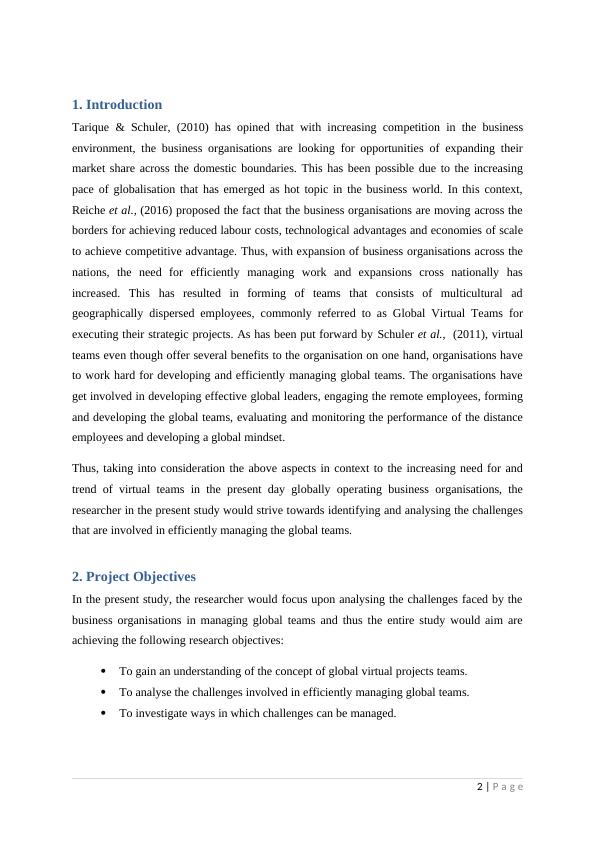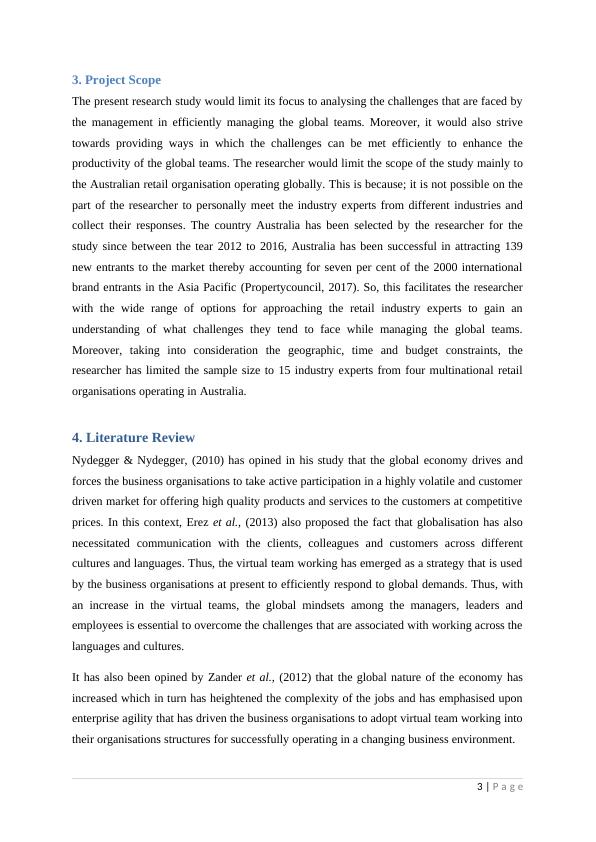Challenges Analysing Challenges in Managing Global Teams 1. Introduction 2 3. Project Scope 3 4. Research Gap 5 5. Research Instrumentation 6 Quantitative Research Instrument 6 Quantitative Data Analy
Added on 2020-03-23
12 Pages3256 Words412 Views
Analysing Challenges in Managing Global Teams

Table of Contents1. Introduction.......................................................................................................................................22. Project Objectives..............................................................................................................................23. Project Scope.................................................................................................................................34. Literature Review..............................................................................................................................3Problem Statement.............................................................................................................................5Research Gap.....................................................................................................................................55. Research Questions...........................................................................................................................66. Research Design and Methodology...................................................................................................6Quantitative Research........................................................................................................................6Research Instrument..........................................................................................................................6Quantitative Data Analysis Process...................................................................................................7Sampling and Sample Size................................................................................................................7Questionnaire design.........................................................................................................................7Reliability and Validity of Data.........................................................................................................77. Research Limitations.........................................................................................................................88. Time Schedule...................................................................................................................................89. Conclusion.........................................................................................................................................9References...........................................................................................................................................10Reference List......................................................................................................................................121 | Page

1. IntroductionTarique & Schuler, (2010) has opined that with increasing competition in the businessenvironment, the business organisations are looking for opportunities of expanding theirmarket share across the domestic boundaries. This has been possible due to the increasingpace of globalisation that has emerged as hot topic in the business world. In this context,Reiche et al., (2016) proposed the fact that the business organisations are moving across theborders for achieving reduced labour costs, technological advantages and economies of scaleto achieve competitive advantage. Thus, with expansion of business organisations across thenations, the need for efficiently managing work and expansions cross nationally hasincreased. This has resulted in forming of teams that consists of multicultural adgeographically dispersed employees, commonly referred to as Global Virtual Teams forexecuting their strategic projects. As has been put forward by Schuler et al., (2011), virtualteams even though offer several benefits to the organisation on one hand, organisations haveto work hard for developing and efficiently managing global teams. The organisations haveget involved in developing effective global leaders, engaging the remote employees, formingand developing the global teams, evaluating and monitoring the performance of the distanceemployees and developing a global mindset.Thus, taking into consideration the above aspects in context to the increasing need for andtrend of virtual teams in the present day globally operating business organisations, theresearcher in the present study would strive towards identifying and analysing the challengesthat are involved in efficiently managing the global teams.2. Project ObjectivesIn the present study, the researcher would focus upon analysing the challenges faced by thebusiness organisations in managing global teams and thus the entire study would aim areachieving the following research objectives:To gain an understanding of the concept of global virtual projects teams.To analyse the challenges involved in efficiently managing global teams.To investigate ways in which challenges can be managed.2 | Page

3. Project ScopeThe present research study would limit its focus to analysing the challenges that are faced bythe management in efficiently managing the global teams. Moreover, it would also strivetowards providing ways in which the challenges can be met efficiently to enhance theproductivity of the global teams. The researcher would limit the scope of the study mainly tothe Australian retail organisation operating globally. This is because; it is not possible on thepart of the researcher to personally meet the industry experts from different industries andcollect their responses. The country Australia has been selected by the researcher for thestudy since between the tear 2012 to 2016, Australia has been successful in attracting 139new entrants to the market thereby accounting for seven per cent of the 2000 internationalbrand entrants in the Asia Pacific (Propertycouncil, 2017). So, this facilitates the researcherwith the wide range of options for approaching the retail industry experts to gain anunderstanding of what challenges they tend to face while managing the global teams.Moreover, taking into consideration the geographic, time and budget constraints, theresearcher has limited the sample size to 15 industry experts from four multinational retailorganisations operating in Australia. 4. Literature ReviewNydegger & Nydegger, (2010) has opined in his study that the global economy drives andforces the business organisations to take active participation in a highly volatile and customerdriven market for offering high quality products and services to the customers at competitiveprices. In this context, Erez et al., (2013) also proposed the fact that globalisation has alsonecessitated communication with the clients, colleagues and customers across differentcultures and languages. Thus, the virtual team working has emerged as a strategy that is usedby the business organisations at present to efficiently respond to global demands. Thus, withan increase in the virtual teams, the global mindsets among the managers, leaders andemployees is essential to overcome the challenges that are associated with working across thelanguages and cultures.It has also been opined by Zander et al., (2012) that the global nature of the economy hasincreased which in turn has heightened the complexity of the jobs and has emphasised uponenterprise agility that has driven the business organisations to adopt virtual team working intotheir organisations structures for successfully operating in a changing business environment.3 | Page

End of preview
Want to access all the pages? Upload your documents or become a member.
Related Documents
Challenges Managing Global Teams: Literature Review and Research Designlg...
|18
|3900
|218
HI6008 - Challenges with Managing Global Teamlg...
|14
|2611
|104
The Australian Universities and Courses that I Have to Enrol in: A Research Gap for International Studentslg...
|15
|4127
|303
(PDF) Challenges In Managing Virtual Teamslg...
|16
|3913
|72
BUSN4100 - Business Research Method, Research Proposallg...
|12
|2541
|255
Business Research - ways of managing the global teams in a smooth mannerlg...
|13
|2143
|515
